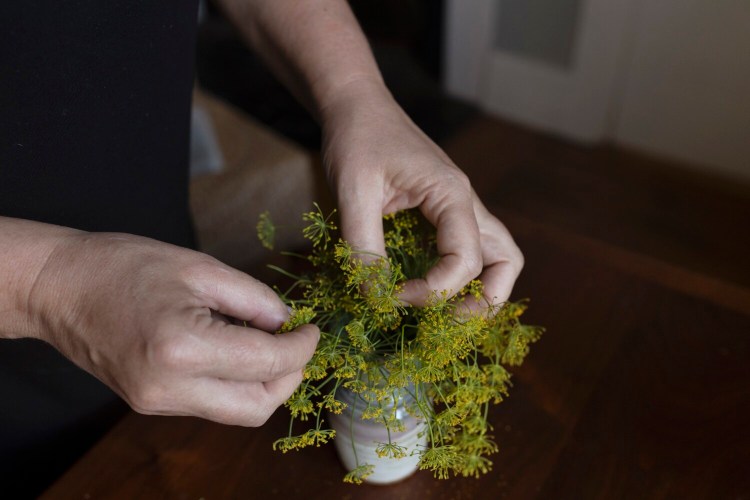Dill blossoms are my new favorite herb.
I bought my first bunch in early August because I’d gotten to the market too late to snag fresh-cut flowers from a floral vendor. I spotted the dill blooms at a vegetable farmer’s display, sitting next to the basil in a neat bunch, and I thought the starburst blooms were beautiful. I put the lacy, yellow lovelies in a small vase next to my cutting board because they made me smile while cooking.
I was on a late morning Zoom call on a Friday a few days after my purchase when a visiting friend got hungry for lunch. She’s a great cook who has carte blanche access to my kitchen, and she usually manages some of whatever she’s making for me, too. She grilled some goat halloumi and sauteed a couple of young zucchinis with garlic and onions. She felt the vegetables tasted a little flat, so she snipped a few blossoms from my dill bouquet and tossed them into the pan. They were an interesting addition because the green umbles (inflorescences comprising several short flower stalks called pedicels that spread from a common point like the ribs of an umbrella) still carry the semi-sour taste chopped sprigs of dill do, but the buds and their pollen themselves impart a sweet, honeyed, floral finish and a pleasant crunchy texture that pops.
I’ve had tremendous success using them in and on everything since. I’ve mixed them in mayonnaise on roast beef sandwiches. Stirred them into egg salad. Schmeared others with cream cheese on morning bagels. Stuffed whole flowers into jars with cucumbers for pickles. Added them to yogurt and more grated cucumbers to make raita to chill spicy Indian food. Garnished gazpacho shots with single umbles. Mixed them into the vinegary dressing for warm potato salad. And nibbled them plain just because they are simply that interesting, and they erase coffee breath.
Since becoming obsessed with dill blossoms, I’ve also learned a few things about them. They store best in a vase on the counter. Putting them in the fridge makes them droop. Plus, having the blooms in plain sight means you’ll remember to use them often. And an equal amount of chopped dill blossoms can be substituted for chopped dill weed.
Placing the vase on a plate means you catch the pollen that the flowers shed, and that’s where that honeyed, floral taste comes from. Dill pollen, an arguably cheffy ingredient, sells for about $50 per ounce. In your kitchen, it will drop from the dill flowers onto the plate and can be stored in a spice jar. Sprinkle it over cooked rice you’re serving with chicken or fish, or use as a flavor agent in whipped ricotta dip or in a sweet or savory goat cheese tart. Add dill pollen to the mix at the end of the cooking process, as exposing it to heat for long periods of time renders it tasteless.
And lastly, dill flowers are formed when dill weed is bolting on its way to going to seed. Therefore, selling the blossoms as a secondary product at market gives farmers added income on their investment in the dill seed they planted. Eating dill blossoms is not only a delicious prospect, then, but also a step you can take to expand your support of sustainable farming in Maine.

Add the dill blossoms near the end of preparing dishes, like this warm potato salad. Brianna Soukup/Staff Photographe
Warm Potato Salad with Vinegar, Honey and Dill Blossoms
This salad is great to bring to a backyard Labor Day barbecue, as you don’t have to worry about refrigeration, as you would a potato salad that was dressed in mayonnaise.
Serves 4-6 as a side dish
2 pounds mixed potatoes
Kosher salt
1/4 cup chopped red onion
1/4 cup apple cider vinegar
1/4 cup olive oil
2 tablespoons course, grainy mustard
2 tablespoons chopped capers
1 tablespoon chopped dill blossoms
Black pepper
Wash potatoes and cut them into 1-inch pieces. Place them in a pot, cover them with cold water and stir in 1 tablespoon salt. Cover the pot and place it over high heat. When the water boils, cock the lid, reduce the heat slightly and simmer potatoes until just fork tender, 6-7 minutes. Drain potatoes and return them to the pot. The potatoes will steam dry as you make the dressing.
Combine red onion and vinegar in a large bowl. Let sit 5 minutes. Add oil, mustard and capers. Add warm potatoes and stir to coat. Let rest 5 minutes and toss well again. Let rest 5 minutes more. Add dill blossoms and black pepper to taste. Toss one last time and serve warm or at room temperature.
Christine Burns Rudalevige is a food writer, recipe developer, tester and cooking teacher in Brunswick, and the author of “Green Plate Special,” a cookbook from Islandport Press based on these columns. She can be contacted at: cburns1227@gmail.com
Copy the Story LinkSend questions/comments to the editors.



Success. Please wait for the page to reload. If the page does not reload within 5 seconds, please refresh the page.
Enter your email and password to access comments.
Hi, to comment on stories you must . This profile is in addition to your subscription and website login.
Already have a commenting profile? .
Invalid username/password.
Please check your email to confirm and complete your registration.
Only subscribers are eligible to post comments. Please subscribe or login first for digital access. Here’s why.
Use the form below to reset your password. When you've submitted your account email, we will send an email with a reset code.